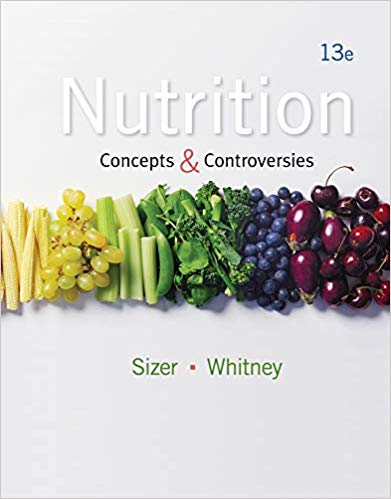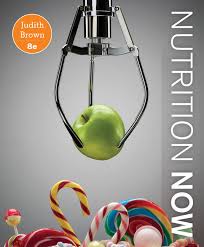Test Bank for Nutrition Concepts and Controversies 13th Edition By by Frances Sienkiewicz Sizer
Original price was: $75.00.$45.00Current price is: $45.00.
Test Bank For Nutrition Concepts And Controversies 13th Edition is an essential tool for any student of nutrition. The Test Bank provides students with a wealth of questions, both multiple choice and essay, that cover all of the major concepts covered in the textbook. The Test Bank also includes answer keys for all of the questions, as well as explanations of the correct answers.
In addition, the Test Bank includes study guides for each chapter of the textbook, which provide an overview of the key concepts covered in each chapter. With the Test Bank, students will have everything they need to master the material covered in Nutrition Concepts And Controversies.
Digital item No Waiting Time Instant Download
ISBN-10 : 142394397XISBN-13 : 978-1423943976
Description
Test Bank for Nutrition Concepts and Controversies 13th Edition By by Frances Sienkiewicz Sizer
Chapter 3 – The Remarkable Body
Chapter Learning Objectives
3.1 Describe the levels of organization in the body, and identify some basic ways in which nutrition supports them.
3.2 Describe the relationships between the body’s fluids and the cardiovascular system and their importance to the nourishment and maintenance of body tissues.
3.3 Summarize the interactions between the nervous and hormonal systems and nutrition.
3.4 State how nutrition and immunity are interrelated, and describe the importance of inflammation to the body’s health.
3.5 Compare the terms mechanical digestion and chemical digestion, and point out where these processes occur along the digestive tract with regard to carbohydrate, fat, and protein.
3.6 Name some common digestive problems and offer suggestions for dietary alterations that may improve them.
3.7 Identify the excretory functions of the lungs, liver, kidneys, and bladder, and state why they are important to maintain normal body functioning.
3.8 Identify glycogen and fat as the two forms of nutrients stored in the body, and identify the liver, muscles, and adipose tissue as the body tissues that store them.
3.9 Define the term moderate alcohol consumption, and discuss the potential health effects, both negative and positive, associated with this level of drinking.
True/False Items
1. Cells are organized into tissues that perform specialized tasks and tissues, in turn, are grouped together to form whole organs.
2. Body fluids supply the tissues continuously with energy, oxygen, and nutrients, including water.
3. Chewing food for an extended time provides additional advantages to digestion.
4. Timing of meals is important because the digestive tract is unable to digest food at certain times.
5. Some nutrients are stored in the body in much smaller quantities than others are.
6. Some vitamins are stored in the body without limit, even if they reach toxic levels.
7. The pancreas releases glucagon to remove glucose from blood and store it in muscles.
8. The hypothalamus in the brain monitors many body conditions, including the availability of nutrients and water.
9. Inflammation is the immune system’s normal, healthy response to cell injury.
10. Frequent use of laxatives is an effective way to prevent constipation.
11. Waste materials dissolved in water are collected by the kidneys and become concentrated as urine.
Comprehension-Level Multiple-Choice Items
1. Cells can best be described as:
a. the basis of the body’s design.
b. the vital components of foods.
c. self-contained living entities.
d. building blocks of the body.
2. Among the cells’ most basic needs are _____ and the oxygen with which to burn it.
a. water
b. essential nutrients
c. building blocks
d. energy
3. The first principle of diet planning is that the foods we choose must provide energy and the essential nutrients, including:
a. water.
b. fuel.
c. oxygen.
d. carbon dioxide.
4. Which of the following determines the nature of the cell’s work?
a. organs
b. mutations
c. red blood cells
d. genes
5. Cells lining the digestive tract replace themselves every:
a. 3 days.
b. 2 weeks.
c. 4 months.
d. 12 months.
6. Which of the following cells normally replace themselves once every few years?
a. muscle
b. skin
c. digestive tract
d. red blood
7. Which of the following types of cells do not reproduce, and if damaged by injury or disease, are lost forever?
a. skin cells
b. red blood cells
c. muscle cells
d. brain cells
8. The body’s circulating fluids include:
a. intracellular fluid.
b. blood.
c. lymph.
d. a and b
e. b and c
9. The blood picks up oxygen and releases carbon dioxide in the:
a. heart.
b. liver.
c. digestive system.
d. lungs.
10. Which of the following has the special task of chemically altering absorbed materials to make them better suited for use by other tissues?
a. liver
b. pancreas
c. stomach
d. small intestine
11. When the pancreas detects a high concentration of the blood’s sugar, glucose, it releases:
a. lymph.
b. insulin.
c. antibodies.
d. glucagon.
12. Hormones are secreted and released into the blood by _____.
a. antigens
b. enzymes
c. glands
d. antibodies
13. Which of the following alert(s) your conscious mind to the sensation of hunger?
a. hypothalamus
b. stomach muscles
c. taste buds
d. a and b
e. b and c
14. The nervous system’s role in hunger regulation is coordinated by the:
a. pancreas.
b. brain.
c. digestive tract.
d. spinal cord.
15. Which of the following does not occur as part of the stress response?
a. The muscles tense up.
b. The liver pours forth glucose from its stores.
c. The digestive system speeds up.
d. The fat cells release fat.
16. Which of the following are the first to defend the body tissues against invaders?
a. phagocytes
b. antigens
c. T-cells
d. B-cells
17. Which of the following poses a formidable obstacle to a successful organ transplant?
a. phagocytes
b. T-cells
c. B-cells
d. antibodies
18. The inflammation that tissues undergo when they become injured or irritated:
a. is an abnormal, unhealthy response to cell injury.
b. results in decreased white cells.
c. may involve loss of function of the affected body part.
d. is difficult to detect because it has no obvious symptoms.
19. Most people have aversions to _____ tastes.
a. sweet
b. salty
c. fatty
d. bitter
20. The digestive tract needs _____, which provides the bulk against which the muscles of the colon can work.
a. energy
b. fiber
c. nutrients
d. water
21. The primary organ of digestion and absorption is the:
a. mouth.
b. stomach.
c. small intestine.
d. large intestine.
22. The stomach’s main function is the digestion of what nutrient?
a. protein
b. carbohydrate
c. fat
d. fiber
23. The purpose of the villi and microvilli in the intestinal tract is to:
a. move food components through the intestinal tract to be removed from the body.
b. reduce the absorbing surface of the intestines.
c. trap the nutrient particles and absorb them into the cells.
d. prevent nutrients from being absorbed.
24. In cases of severe undernutrition, the small intestine will react by:
a. shrinking to a much smaller surface.
b. expanding to a much larger surface.
c. increasing intestinal muscle activity.
d. increasing the amount of nutrients absorbed.
25. The major function of the kidneys is to:
a. dilute wastes in water so they can recirculate in the body.
b. capture nutrients and return them to the blood.
c. excrete wastes from the body in urine.
d. remove fluid from the bladder.
26. The liver converts excess energy-containing nutrients into:
a. glycogen.
b. protein.
c. fat.
d. a and b
e. a and c
27. Which of the following is characteristic of liver glycogen?
a. It is stored for the body’s ongoing glucose needs.
b. It can be released into the blood as glucose.
c. It represents a three-day supply of glucose.
d. a and b
e. b and c
28. Without food to replenish it, the liver’s glycogen supply can be depleted within as few as:
a. 1-3 hours.
b. 3-6 hours.
c. 4-8 hours.
d. 6-9 hours.
29. The bones provide reserves of:
a. vitamins.
b. calcium.
c. glycogen.
d. a and b
e. b and c
30. Which of the following is not one of the major storage sites that store nutrients for release to meet the cells’ needs between meals?
a. liver
b. muscles
c. fat cells
d. pancreas
Application-Level Multiple-Choice Items
31. Cells are related to the nutrients we eat in foods because:
a. cells create certain essential nutrients if we do not eat enough of them.
b. all cells replenish themselves every few days with nutrients that are consumed.
c. nutrients can affect how the genes in cells work.
d. enzymes are created to slow down the chemical reactions of a nutrient.
32. A gene variation in the cells can occasionally cause an inborn error of metabolism. If this is discovered by a healthcare provider, the advice would be to:
a. not worry because this is a temporary condition.
b. eat a special diet that will minimize its potential harm to the body.
c. obtain a tissue transplant that will introduce new genes to the cells.
d. avoid all processed foods.
33. The importance of the lungs in the circulatory system is that they are responsible for:
a. adding oxygen to the blood.
b. removing glucose from the blood.
c. adding nutrients to the blood.
d. removing extra water from the blood.
34. Nutrients delivered from the intestines into the circulatory system are:
a. transported through the blood to the liver for chemical alterations to make them better suited for use by the tissues.
b. transported to the heart, which then delivers them to the individual cells in the body.
c. transported to the kidneys, which send them to the cells in the body.
d. transported through the lymph system to the heart for distribution.
35. A person can eat when hunger is absent because:
a. the hypothalamus monitors the availability of nutrients.
b. the conscious mind of the cortex can override body signals.
c. the digestive tract sends messages to the hypothalamus.
d. the stomach intensifies its contractions and creates hunger pangs.
36. During the fight-or-flight reaction to stress the nervous system reacts by:
a. temporarily shutting down metabolism.
b. slowing down breathing to conserve oxygen.
c. releasing stored glucose from the liver.
d. speeding up the work of the digestive system.
37. What is the role of the phagocytes and lymphocytes in protecting the body from invading organisms?
a. Phagocytes release antibodies against the invaders into the bloodstream.
b. T-cells release a chemical trail for identification of invaders.
c. B-cells engulf and digest the foreign particles.
d. Killer T-cells seek out and destroy all foreign particles with the same identity.
38. Chronic, low-grade inflammation in chronic disease is of interest because:
a. it is an indication that the disease process is improving.
b. it foretells of the risk of death from the disease.
c. an important predictor is being underweight.
d. no dietary factors can have an effect on its progression.
39. When given a choice between tasting a snack of cookies, potato chips, or dill pickles, most people would:
a. select the pickle because we have a universal desire for sour foods.
b. avoid the potato chips because most people don’t like a salty taste.
c. select the cookies because of our preference for sweet tastes.
d. avoid the cookies because of a common dislike for the taste of fat.
40. Digestion of foods includes the mechanical actions of:
a. chewing to allow some nutrients to be absorbed into the body through the tongue.
b. peristalsis waves to move the foods down through the digestive tract.
c. the stomach to gently release foods into the small intestine.
d. the small intestine to absorb water and create the paste that forms feces.





Be the first to review “Test Bank for Nutrition Concepts and Controversies 13th Edition By by Frances Sienkiewicz Sizer”